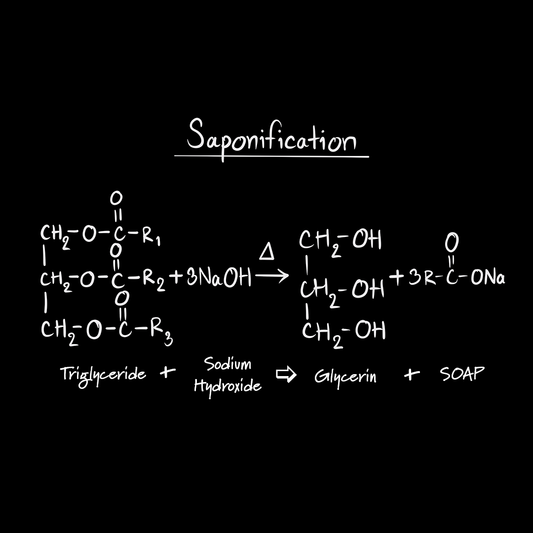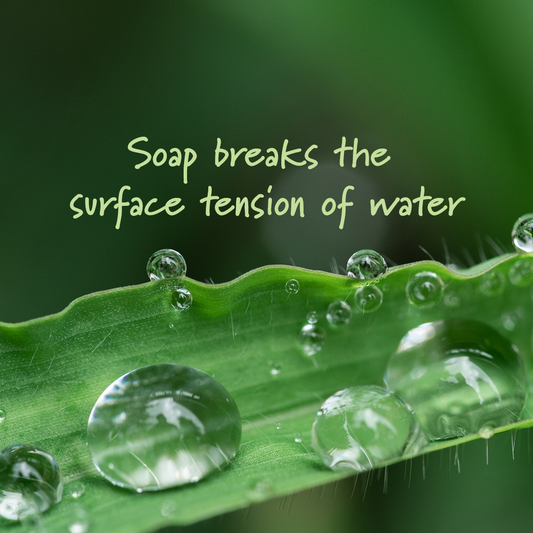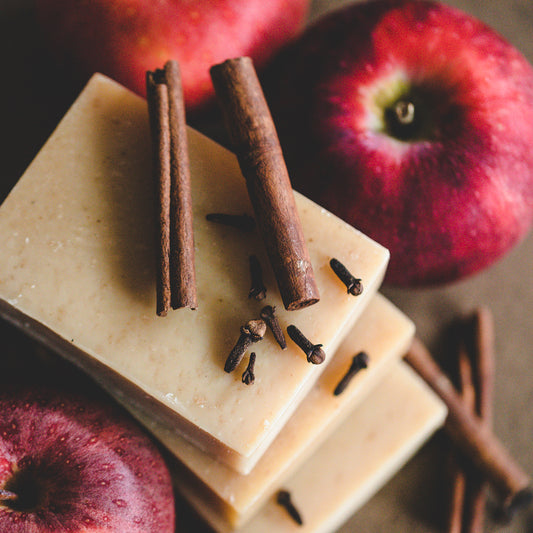How Does Natural Soap Create Lather?
When I was a teacher my favorite students were the ones who asked lots of questions. It meant they were engaged, interested, curious, and had a desire to learn and understand new concepts.
That also describes our customers! The members of our extended Chagrin Valley family are always eager to learn and they ask the best questions. For me, each of these questions becomes a teachable moment and often a blog.
We recently received an excellent question. "If your natural soap does not contain synthetic foam boosters like sulfates, how does it lather?"
What Are Bubbles?
 Most of us can remember as children how we were able to create lots of bubbles by blowing through a straw into our glass of milk. If the glass was not too full I could easily fill the glass with loads of bubbles until my mom would tell me to stop playing with my food.
Most of us can remember as children how we were able to create lots of bubbles by blowing through a straw into our glass of milk. If the glass was not too full I could easily fill the glass with loads of bubbles until my mom would tell me to stop playing with my food.
But if we tried the same "experiment" using water it did not work as well. The bubbles did not foam up and they popped very quickly.
The water bubbles were less stable because the surface tension (more about that later) pulls the water molecules back together.
Why the difference? The milk contains milk proteins and fats. These proteins and fats form a film in the bubble which makes it stronger and more stable. Milk (especially whole milk) has a lower surface tension than water. Whenever surface tension is reduced, bubbles are more stable.
So What About Soap Bubbles?
There are many different kinds of "soap" products and they have one major thing in common, they can make bubbles.
When you gather a bunch of tiny soap bubbles together, it is called lather. Whether it is a bar of natural soap or shampoo or synthetic detergent soaps, dishwashing liquid, or even laundry detergent, the process of bubble making is basically the same.
To understand the bubble-producing secret of soap, we need to explore the chemistry of soap molecules and water molecules. Here comes the science!!
Properties of Water: Surface Tension
 Have you ever done a “belly flop” into a swimming pool—ouch it hurts!
Have you ever done a “belly flop” into a swimming pool—ouch it hurts!
But how is that possible? While we know that water is not hard, your poor belly would disagree.
If you could see molecules of water and how they behave with each other, you would notice that each water molecule is actually attracted to its neighbors.
Each water molecule has two hydrogen atoms and one oxygen atom. The two hydrogen atoms (the Mickey Mouse ears) of one molecule are attracted to the oxygen atoms of other nearby molecules. This attraction is called "hydrogen bonding."
Within the body of the water, away from the surface, each and every molecule is involved in a pushing and pulling tug of war with its neighbors on all sides.
But on the surface of the water, the molecules behave differently.
Since there are no water molecules above the surface, the surface molecules are pulled back into the liquid by the water molecules below them. As the molecules on the surface of the pool are pulled tightly together, they form a “skin” like a thin layer of plastic wrap called surface tension.

Surface tension is the result of cohesion which is defined as the "sticking-together" of particles. It is the attraction of particles to one another at the surface of a liquid.
While all liquids have some sort of surface tension, the stronger the forces between the molecules (intermolecular forces), the greater the cohesion. Water has strong intermolecular forces--they are the hydrogen bonds described above.
So, whenever you hit the water, you have to break the surface tension of the water to enter. When you dive or jump into a pool you break through a small amount of the water with your hands or feet. But your belly has a large surface area and thus a larger amount of surface “skin” to break through.
Surface Tension & Natural Soap
Watch the small video below and notice how the water droplets that I place on waxed paper bead up into tiny dome-like balls due to surface tension.
Then see what happens to the surface tension of the water when I introduce some soap. Soap is a natural surfactant, which is short for "surface active agent." Surfactants reduce the surface tension of water.
Video
Water will normally hold to itself because each water molecule is surrounded by and attracted to other water molecules. The property of surface tension causes water to bead up on surfaces, like my wax paper. In order for the water to spread and wet a surface (like your skin) – you need surfactants.
Surface Tension & Natural Soap Explanation
 Soap molecules have two very different ends, the end that likes to stick to water is called the water-loving or hydrophilic end and the end that repels water is called the water-hating or hydrophobic end.
Soap molecules have two very different ends, the end that likes to stick to water is called the water-loving or hydrophilic end and the end that repels water is called the water-hating or hydrophobic end.
The soap molecule acts as a connecting bridge. Its hydrophilic end attaches to a water molecule and its hydrophobic end attaches to a greasy dirt or oil molecule.
When you rinse the soap off of your skin, the hydrophilic (water-loving end) end of the soap molecule gets washed away with the water and takes the hydrophobic end with the dirt and oil along with it.
Since our blog, "How Does Soap Work" discusses the process by which soap works to clean your body, I will not repeat the whole process here!
So, How Does Natural Soap Lather?
When natural soap mixes with water it has a tendency to create thin sheets in which a thin layer of water molecules is sandwiched between two layers of soap molecules.
The soap molecules actually trap water in a thin layer, creating a film like that seen in the picture. Picture from: itsokaytobesmart

Notice how the layer of (blue and yellow) water molecules is surrounded on either side by soap molecules with the hydrophilic end (red) pointed towards the water, and the hydrophobic tail pointed away from the water.
When you rub a bar soap over your wet skin, washcloth, or scrubby you create friction. This friction introduces tiny air bubbles onto the surface of the wet soap.
The hydrophobic (water-repelling) end does not like the wet, watery soap and wants to leave, so it attaches itself to the nearest air bubble.
Soon the air bubbles are covered in the hydrophobic ends of the soap molecules. This creates a thin film that encloses a tiny bit of air.
What do we call that? A soap bubble! 
If we could cut a bubble in half we would see something like the picture on the right.
The bubble is filled with air in the center and the surface of the soap bubble is a thin layer of water molecules (red and white) sandwiched between two layers of soap molecules, one on the inside and the other on the outside of the bubble.
The blue circles are the "hydrophilic end of the soap molecule and the black tail is the hydrophobic end.
These layers work together to hold air inside.
The interaction between the soap bubbles pushes the water molecules away from each other relieving surface tension.
So a natural soap bubble is just air wrapped in a film made from soap and water. The air bubbles are now trapped, and lots of trapped air bubbles covered in soap molecules are what we call soap lather.
Back to the Question: How Does Natural Soap Create Lather?
"If your soap does not contain SLS or other foam boosters, how does it lather?"
At the beginning of this blog I mentioned that if you try to make bubbles using plain water, you will quickly see it does not work very well. This is because the cohesion and thus the surface tension, the forces holding the molecules together, of water is too high.
The secret to making good bubbles is to decrease the surface tension of the water. Adding natural soap to water changes the surface tension of water and allows stable bubbles, and thus lather, to form.
 Almost all cleansing products are based on some type of surfactant.
Almost all cleansing products are based on some type of surfactant.
Surfactants not only reduce the surface tension of the water but the way they are constructed (with one hydrophilic end and one hydrophobic end) makes them compatible with both water and oils.
This property is what makes them good for cleansing. When surfactants lower the surface tension of water, they basically make the water molecules more slippery, so they are less likely to stick to themselves and more likely to interact with oil and grease.
Natural soap needs no synthetic additives to create lather or to clean, because natural soap is a natural surfactant. So it not only makes great bubbles and lather, but it also helps clean oily dirt from your skin--naturally!
Also, the ingredients used to formulate a natural bar of soap as well as curing time contribute to the type of lather a soap bar produces. Oils such as coconut and castor oil help create a bubbly, foamy, rich lather. On the other hand, soaps made primarily with olive oil, such as Castile-type soaps, will produce a rich and creamy rather than bubbly lather. The naturally retained glycerin in handmade soap also helps create a lovely lather.
Handmade natural soap needs to "cure." During the curing process, the remaining water slowly evaporates over time which causes the soap to harden. We cure our soaps for about 8 to 10 weeks depending on the recipe. While a bar of handmade soap is safe to use after just a few weeks, a properly cured bar of natural soap will be milder, last longer, and produce copious amounts of bubbly lather.
Commercial Soaps & Lather
 There are also many synthetic surfactants. Syndets (synthetic detergents) are all surfactants and the word detergent is often used as a synonym for the word surfactant.
There are also many synthetic surfactants. Syndets (synthetic detergents) are all surfactants and the word detergent is often used as a synonym for the word surfactant.
Since some sort of surfactant is needed to wash oily dirt away, if the cleansing product you are using on your face, body, or hair is not real soap, or claims to be "soap-free" then it is made with synthetic surfactants, basically detergents.
Commercial "soaps" (which are not really soap at all) use synthetic detergents that clean and act as foam boosters or foaming agents to provide the copious amounts of lather that consumers love.
These chemicals are very inexpensive and many serve no purpose other than to provide thick, foamy lather which is not really needed to get clean.
So create some natural lather with an organic soap and help your skin and our planet!


